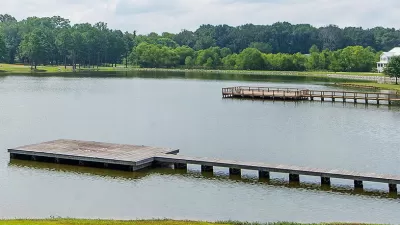Galina Tachieva's new Sprawl Repair Manual creates a narrative and visual process for making suburbs more sustainable. The book's first chapter is available now online.
Tachieva explains what she sees as sprawl:
"Sprawl is a pattern of growth characterized by an abundance of congested highways, strip shopping centers, big boxes, office parks, and gated cul-de-sac subdivisions-all separated from each other in isolated, single-use pods. This land-use pattern is typically found in suburban areas, but also affects our cities, and is central to our wasteful use of water, energy, land, and time spent in traffic. Sprawl has been linked to increased air and water pollution, greenhouse gas emissions, loss of open space and natural habitat, and the exponential increase in new infrastructure costs. Social problems related to the lack of diversity have been attributed to sprawl, and health problems such as obesity to its auto-dependence.
In contrast, complete communities have a mix of uses and are walkable, with many of a person's daily need-shops, offices, transit, civic and recreational places-within a short distance of home. They are compact, so they consume less open space and enable multiple modes of transportation, including bicycles, cars, and mass transit. A wide variety of building types provides options to residents and businesses, encouraging diversity in population. This mix of uses, public spaces, transportation, and population makes complete communities economically, socially, and environmentally sustainable."
Thanks to Simmons Buntin
FULL STORY: Sprawl Repair: From Sprawl to Complete Communities

Planetizen Federal Action Tracker
A weekly monitor of how Trump’s orders and actions are impacting planners and planning in America.

Trump Administration Could Effectively End Housing Voucher Program
Federal officials are eyeing major cuts to the Section 8 program that helps millions of low-income households pay rent.

The 120 Year Old Tiny Home Villages That Sheltered San Francisco’s Earthquake Refugees
More than a century ago, San Francisco mobilized to house thousands of residents displaced by the 1906 earthquake. Could their strategy offer a model for the present?

Washington State Legislature Passes Parking Reform Bill
A bill that would limit parking requirements for new developments is headed to the governor’s desk.

Missouri Law Would Ban Protections for Housing Voucher Users
A state law seeks to overturn source-of-income discrimination bans passed by several Missouri cities.

Op-Ed: Looking for Efficiency? Fund Intercity Buses
Much less expensive than rail, intercity buses serve millions of Americans every year, but public subsidies are lacking.
Urban Design for Planners 1: Software Tools
This six-course series explores essential urban design concepts using open source software and equips planners with the tools they need to participate fully in the urban design process.
Planning for Universal Design
Learn the tools for implementing Universal Design in planning regulations.
Ada County Highway District
Clanton & Associates, Inc.
Jessamine County Fiscal Court
Institute for Housing and Urban Development Studies (IHS)
City of Grandview
Harvard GSD Executive Education
Toledo-Lucas County Plan Commissions
Salt Lake City
NYU Wagner Graduate School of Public Service





























